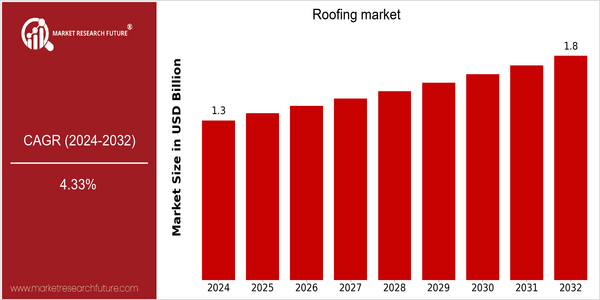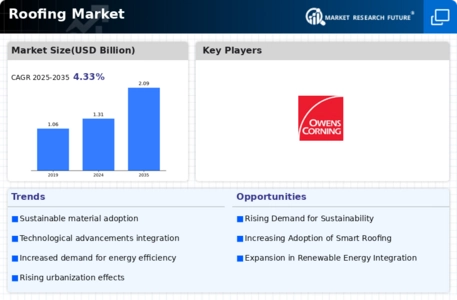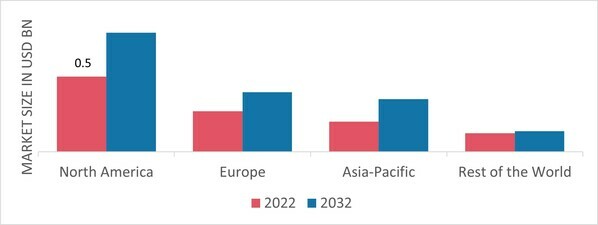Roofing Size
Market Size Snapshot
| Year | Value |
|---|---|
| 2024 | USD 1.310625 Billion |
| 2032 | USD 1.84 Billion |
| CAGR (2024-2032) | 4.33 % |
Note – Market size depicts the revenue generated over the financial year
The world roofing market is a growth market with a market size of about $ 1.3 billion in 2024, which is expected to reach $ 1.8 billion by 2032. This corresponds to a CAGR of 4.33% for the forecast period from 2024 to 2032. The increasing demand for residential and commercial construction and the need for sustainable and energy-efficient roof solutions are driving this growth. Also, the increasing urbanization and the growing need for building and infrastructure are expected to benefit the roofing industry. Also, technological developments such as the integration of smart roof systems and the use of new materials are expected to drive market growth. For example, GAF and Owens Corning are driving product innovation with new and more durable roofing solutions. Strategic initiatives, such as the formation of strategic alliances and the establishment of joint ventures, are also expected to drive the market. The industry is also expected to adapt to the changing preferences and regulatory standards of consumers.

Regional Market Size
Regional Deep Dive
Roofs are undergoing dynamic growth in many regions, driven by increasing urbanization, the development of the construction industry and the increasing demand for energy efficiency. In North America, the market is characterized by strong demand for new roofing materials and technology, especially in the residential sector. In Europe, there is a shift towards sustainable roofing solutions, driven by the increasingly stricter environment regulations. The Asia-Pacific region is growing rapidly, mainly driven by the growth of the construction industry and the middle class. In the Middle East and Africa, growth is driven by investments in the transport system. In Latin America, the focus is on low-cost housing, which requires durable roofing solutions.
Europe
- The European Union's Green Deal is significantly influencing the roofing market, pushing for the use of sustainable materials and energy-efficient designs, which has led to increased demand for green roofs and solar-integrated roofing systems.
- Companies like BMI Group are leading innovations in roofing solutions, focusing on lightweight materials and modular designs that cater to the region's emphasis on sustainability and urban regeneration.
Asia Pacific
- Rapid urbanization in countries like India and China is driving the demand for roofing materials, with local governments implementing initiatives to improve housing quality and infrastructure, such as the Pradhan Mantri Awas Yojana in India.
- Innovations in roofing technology, such as the use of bamboo and other sustainable materials, are being explored by companies like Asian Paints, reflecting the region's cultural inclination towards eco-friendly construction practices.
Latin America
- Government initiatives aimed at improving housing conditions, such as Brazil's Minha Casa Minha Vida program, are driving demand for affordable and durable roofing solutions, with a focus on local materials.
- The rise of natural disasters in the region has prompted a shift towards resilient roofing systems, with companies like Eternit investing in research and development to create products that withstand extreme weather conditions.
North America
- In the United States, cool roofs are becoming more common. In order to reduce the urban heat island, the United States Department of Energy is promoting the use of cool roofs.
- Major companies such as GAF and Owens Corning are investing in advanced roofing systems that incorporate solar technology, aligning with the growing trend of integrating renewable energy solutions into building designs.
Middle East And Africa
- The UAE's Vision 2021 is promoting sustainable construction practices, leading to increased investments in energy-efficient roofing solutions, particularly in commercial buildings, supported by companies like Al-Futtaim Engineering.
- The growing trend of prefabricated construction in the region is influencing the roofing market, with firms like Emaar Properties adopting modular roofing systems to expedite project timelines and reduce costs.
Did You Know?
“Approximately 30% of a building's energy loss can be attributed to its roof, making energy-efficient roofing solutions critical for reducing overall energy consumption.” — U.S. Department of Energy
Segmental Market Size
The roofing market is currently growing at a stable rate, driven by a growing demand for energy-efficient and sustainable roofing solutions. There are several reasons for this. The first is the increasing awareness of consumers for the environment and the second is the legislation promoting green building. Also, the development of new roofing materials such as cool roofs and solar-integrated systems is reshaping consumer preferences towards more advanced solutions. The current stage of sustainable roofing technology is one of scaled deployment. The leading companies in North America are GAF and CertainTeed. The most notable projects are the installation of solar-integrated roofs in the residential sector in California, which demonstrates the integration of sustainable solutions. The main application areas are residential, commercial and industrial buildings where energy efficiency and long life are the most important criteria. The macro trends such as government incentives for energy-efficient renovations and the push towards net-zero buildings are also accelerating the market. On the other hand, technological developments such as smart roofing and advanced insulating materials are reshaping the industry.
Future Outlook
From 2024 to 2032, the market for roofing materials is expected to grow at a compound annual growth rate (CAGR) of 4.33%. The strong demand for construction materials in the residential and commercial sectors, fueled by urbanization, population growth, and the increasing need for sustainable building practices, is the main driving force behind this growth. The market penetration of new solutions such as green roofs and solar-integrated systems will also increase significantly as more and more consumers and companies demand energy-efficient and sustainable products. The emergence of new and upcoming materials, the development of new technological solutions, and the emergence of new and supportive government policies will also contribute to the development of the market. Smart solutions enabling the monitoring of the performance and maintenance needs of roofs will be more and more popular with both residential and commercial users. Also, the promotion of energy-efficient building standards and the use of renewable energy sources will stimulate the use of advanced roofing materials. The shift towards high-performance and sustainable solutions will lead to a shift in the market towards innovation and growth.





Leave a Comment